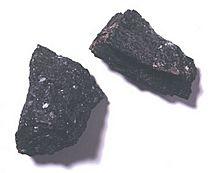Hornblende facts for kids
Hornblende is a group of common minerals found in many rocks. Even though it's called "hornblende," it's not just one specific mineral. Instead, it's a name used for several dark-colored minerals that belong to the amphibole family.
These minerals are made up of different molecules. They often contain elements like calcium, iron, magnesium, and aluminium, combined with silicates.
Hornblende minerals are usually dark. You can find them in shades of green, greenish-brown, brown, or black. They are not see-through. On the Mohs hardness scale, hornblende is a 5 to 6. This means it's about as hard as a knife blade or glass. It also has a specific gravity (how dense it is) of 2.9 to 3.4. People sometimes confuse hornblende with other dark minerals like augite and biotite mica, especially when they are found together in rocks like granite.
Where Hornblende is Found
Hornblende is a very common mineral. You can find it in many different types of rocks. It's often a key part of igneous rocks, which form from cooled magma or lava. Examples include granite, diorite, gabbro, basalt, and andesite.
It's also found in metamorphic rocks. These rocks change due to heat and pressure. Rocks like gneiss and schist often contain hornblende. In fact, hornblende is the main mineral that makes up a type of metamorphic rock called amphibolite.
Sometimes, you might hear about "basaltic hornblende." This is a very dark brown to black type of hornblende that contains titanium. It gets its name because it's usually found in basalt and similar volcanic rocks.
The Name Hornblende
The name "hornblende" comes from the German words horn and blenden. The word blenden means "to blind" or "to dazzle."
The term blende is often used for minerals that have a shiny, non-metallic look, like a glass or resin. For example, zincblende is a shiny zinc ore. Another example is pitchblende, which is a dark, shiny ore that contains uranium.
Images for kids
-
Hornblende diorite from the Henry Mountains, Utah, US
See also
 In Spanish: Hornblenda para niños
In Spanish: Hornblenda para niños



